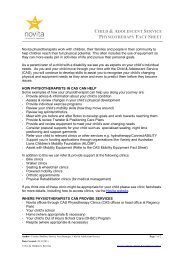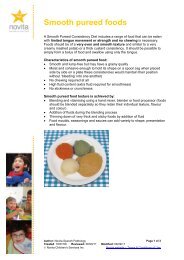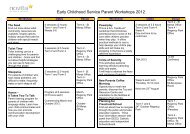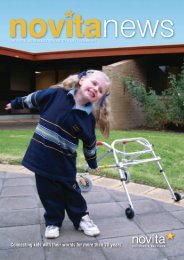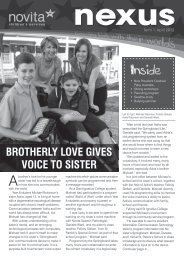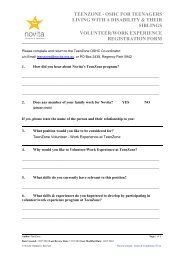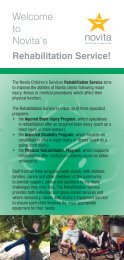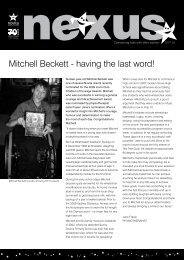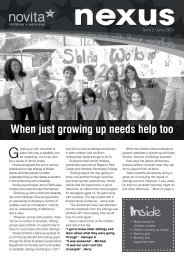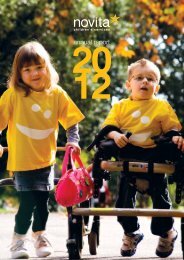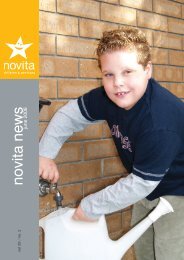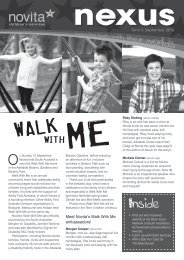Novita Research Report - 2004 to 2007 - Novita Children's Services
Novita Research Report - 2004 to 2007 - Novita Children's Services
Novita Research Report - 2004 to 2007 - Novita Children's Services
- No tags were found...
Create successful ePaper yourself
Turn your PDF publications into a flip-book with our unique Google optimized e-Paper software.
Project summaries53Products and technology for personal indoor and outdoormobility and transportation<strong>Novita</strong> staff contribu<strong>to</strong>rs highlighted in boldProject titleContribu<strong>to</strong>rsSummaryWheelchair usage: tracking wheelchairs and their users – a pilot study usingminiature data loggers (MDLs) <strong>to</strong> identify wheelchair usage patternsDavid Hobbs, Jillian Los (Queensland University of Technology), Dr Lloyd Walker, DrShirley Fitzgerald (University of Pittsburgh, USA), Dr Dan Ding (University of Pittsburgh, USA),Michelle Tolerico (University of Pittsburgh, USA), Robert Bingham (Royal Perth Hospital),Professor John Evans (Queensland University of Technology)There is little published research on how and how often wheelchairs are used in a communitysetting. The purpose of this study is <strong>to</strong> investigate usage patterns and communityparticipation of paediatric wheelchair users in Australia. The University of Pittsburgh’s HumanEngineering <strong>Research</strong> Labora<strong>to</strong>ries have conducted a study by the same name with adultparticipants (see references below), however this study is the first <strong>to</strong> investigate wheelchairusage amongst children. The information that is collected will be combined with that fromPittsburgh <strong>to</strong> produce a broader and more comprehensive study relevant <strong>to</strong> wheelchair usersof all ages.Wheelchair activity is collected via a miniature data logger (MDL) that is attached <strong>to</strong> thespokes of a manual wheelchair’s wheels. It collects information on six variables – the distancetravelled forwards and backwards, the average speed travelled forwards and backwards andthe <strong>to</strong>tal number of times the chair s<strong>to</strong>ps during the day over a three month period. The dataobtained from this pilot study will be significant as it measures and records actual wheelchairactivity rather than perceived or estimated use. The data can then be analysed for trends andpatterns.MethodPotential participants are identified and referred by <strong>Novita</strong> therapists or respond directly <strong>to</strong>an advertisement in one of <strong>Novita</strong>’s publications. Once consent has been given, the MDLis attached <strong>to</strong> the child’s wheelchair and remains there for the duration of the trial. Parentsare asked <strong>to</strong> complete a questionnaire and the chief investiga<strong>to</strong>r interviews the wheelchairuser <strong>to</strong> gauge their feelings on certain aspects of their wheelchair (if they are capable ofanswering the questions posed). The questionnaire contains questions relating <strong>to</strong> the user’sdemographics, their wheelchair and their community participation. The inclusion criteria forparticipants is that they be manual wheelchair users (for greater than 20 hours per week) andbe under 18 years of age.The MDL collects information on all wheelchair movements from the moment it is attached,<strong>to</strong> an accuracy of one third of a wheel rotation. After the trial has been completed the MDLis removed, the raw data is downloaded and processed using a MATLAB program and theinformation is analysed.The MDLs are capable of reporting on wheelchair usage patterns by virtue of three internalsensors and a magnetic pendulum. Each time the pendulum passes a sensor, a time stamp(precise <strong>to</strong> a tenth of a second) and the sensor number is recorded. A motion is determinedas being clockwise or counter-clockwise according <strong>to</strong> the sensor sequence recorded, andforwards or backwards motion can be determined. A MATLAB program analyses the rawdata and reports on activity for all six quantities in hourly intervals (ie 1-2am, 2-3am etc) forevery day of the trial.




